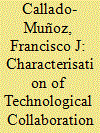| Srl | Item |
| 1 |
ID:
184056


|
|
|
|
|
| Summary/Abstract |
Collaboration with technological partners as an innovation strategy has become widespread in recent years, and all sectors are immersed in this process. In particular, the defence industry is characterised by the technological complexity of the products and services offered, together with a constant innovation process. However, data that allow us to identify characteristics that are found in collaboration contracts are not usually available in this sector. This paper addresses this gap in the literature by studying the different characteristics of both the technological partners and the development agreements for the 1999-2017 period. This is possible thanks to a database of more than 300 collaboration technology agreements between public and private organisations and the Spanish Ministry of Defence. The results provide the Ministry of Defence with a clear picture of the type of collaborations in the Defence industry, their partners and their behaviour under different economic conditions, which will help it identify the type of collaborations that can contribute to improving the design of its innovation strategy.
|
|
|
|
|
|
|
|
|
|
|
|
|
|
|
|
| 2 |
ID:
179752


|
|
|
|
|
| Summary/Abstract |
This paper investigates the intensity of international collaborations in energy-related technologies across OECD and BRIICS countries, by disentangling the role of the distance in environmental policy stringency between countries, controlling for the more traditional measures of technological, social, institutional and geographical distance. In doing so, it distinguishes between the stringency in demand-pull and the stringency in technology-push policy instruments. The analysis relies upon an original dataset, with data on patents and co-patents in climate change and mitigation technologies over the period 1995–2014, with a focus on technologies related to energy generation, transmission or distribution. The results show that the distance in the stringency of environmental policy between countries hinders the intensity of technological collaborations in energy-related technologies and this occurs specifically with reference to demand-pull policy instruments. We also find that while the availability of local technological capabilities positively affects the intensity of international collaborations, if two countries are distant in terms of technological development, the co-patenting activity is hindered. Finally, BRIICS countries display a lower ability to participate in international co-patenting activity, particularly so in collaboration with other BRIICS countries.
|
|
|
|
|
|
|
|
|
|
|
|
|
|
|
|